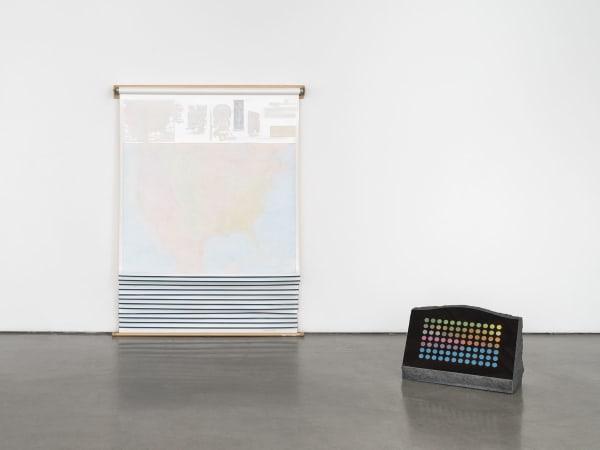Agustina Woodgate: Instructions for Disappearing Territories
François Ghebaly is proud to present Instructions for Disappearing Territories, a new exhibition by Agustina Woodgate.
Buenos Aires-born, Amsterdam-based artist Agustina Woodgate directs a kaleidoscopic practice that bridges systems inquiry and intervention with meticulous, hands-on processes of transformation. Through investigations into material archives, infrastructures, and civic and labor histories, her work excavates underlying mechanisms of power. Woodgate treats the physical artifacts of these mechanisms as raw material to be deconstructed through deliberate acts of erosion and redistribution. These gestures reflect the unique combination of archaeological and durational methodologies that inform her close-looking.
In the exhibition Instructions for Disappearing Territories, Woodgate draws from the broad lines of her practice to unite four interrelated bodies of work, each exposing the systems of labor, value, time, and circulation that shape society. Anchoring the exhibition is the presentation of Woodgate’s WORKOUT (National Times). Featured in the 2019 Whitney Biennial, National Times examines “master-slave” timekeeping, a system and nomenclature for clock synchronization that emerged during the Industrial Revolution and that remains standard-issue in schools, prisons, government offices, factories, and even technology like cell phones. The work contains eight analog “slave” clocks that receive unidirectional commands from a single digital “master” clock. Sandpaper attached to the ends of the “slave” clock hands causes the clocks to slowly wear away their own faces as the artwork progresses.
In works like The Country in Flames (2017-2019) and Wage USA (2020), the artist turns a similar attention to the systems represented through physical currency and outdated educational maps. These works involve the meticulous hand-sanding of bill faces and map surfaces. Importantly, Woodgate stops sanding just before reaching the white of the paper beneath, leaving the ghost or impression of printed information. She saves and sorts the residual ink dust, displaying it in direct relation to the source object and in formats that echo the appearance of consumer goods. In The Country in Flames, a sanded pull-down map of the continental United States retains only the faint appearance of man-made borders, geographic contours, and cartographic elements like legends and insets. Beside the map, 84 colors of ink extracted from its surface are displayed on the face of a black granite headstone. In Wage USA, the black and green dust collected from dollar bills representing one hour of US federal minimum wage is encased in a container resembling a small hourglass lying horizontally. Though the two colors are separated on either side of the glass, a small hole remains intact between the connected halves, leaving the potential for their meticulously isolated contents to mix and reconfigure.
The exhibition also features Tsunami from Woodgate’s ongoing ARC series. ARC (Animal Rug Company) is a social enterprise in which the artist collaborates with Goodwill South Florida to transform discarded stuffed animals into hand-sewn textiles. Titled after natural disasters, each rug engages with a complete cycle of material circulation, where goods manufactured in China are purchased in the USA and eventually donated to thrift stores. The artist’s intervention resurrects these discarded products from mass manufacturing, transforming them into new domestic forms that recombine their former identities through meticulous patterning and craft.
Like Woodgate’s maps and currency, the rugs become palimpsest of greater social, economic, and ecological forces at play. Latent in Woodgate’s deconstructions and the processes she sets in motion are the beginnings of new equations for relating and reorganizing—whether across geographies, through time, or in community.
Agustina Woodgate is a Buenos Aires-born, Amsterdam-based artist. Woodgate received her Master in Arts and Design from Sandberg Instituut in Amsterdam and her Bachelor in Visual Arts from Universidad Nacional de Arte in Buenos Aires. Recent solo exhibitions include Stroom Den Haag, the Hague; Peabody Essex Museum, MA and Barro, Buenos Aires. Her work was included in the 12th Seoul MediaCity Biennial, Seoul; BIENALSUR, Buenos Aires; 2019 Whitney Biennial, New York; 9th Berlin Biennale; Museum of Contemporary Art North Miami; Orlando Museum of Art and Denver Art Museum. In 2026, she will present a solo exhibition at the Prague National Gallery.






